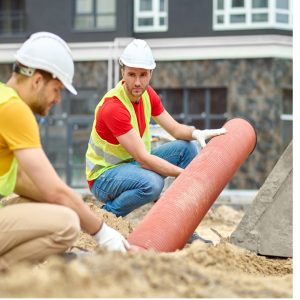Every year, more homeowners turn to trenchless sewer repair, replacement and rehabilitation for their drain line problems. And it’s easy to understand why people consciously pick trenchless piping for their needs.
For one, it helps property owners escape the dreadful disruption and unsightly view caused by trenches. Secondly, there is a myriad of benefits associated with trenchless sewer repairs or replacement:
- Cost-effective
- It can be completed in a shorter period of time
- Safer for homeowners, pedestrians and workers
- More convenient than traditional methods
As a result, trenchless piping is the best way to add or replace drainage pipes in households.
But how exactly does trenchless piping work? What are the different types of trenchless pipe installation and how do they differ?
In this article, Drain Magic explains everything there is to know about no-dig pipe installation.
Drain Magic is the prime partner of homeowners from South Central Pennsylvania in repairing and replacing their underground drains. If you need a service, click here to book an appointment.
That said, read along to explore our homeowners’ essential guide to trenchless piping.
What is Trenchless Piping?
 Trenchless piping is the process of installing new underground pipelines or water conduits using trenchless methods. This pipe installation or replacement approach revolutionizes the traditional process that requires manually digging trenches to place the tubes. Using remote robotics and modern materials, sewer experts can complete the job in hours, versus days with traditional methods.
Trenchless piping is the process of installing new underground pipelines or water conduits using trenchless methods. This pipe installation or replacement approach revolutionizes the traditional process that requires manually digging trenches to place the tubes. Using remote robotics and modern materials, sewer experts can complete the job in hours, versus days with traditional methods.
Alternatively, homeowners not requiring a full-blown pipe replacement may opt for trenchless drain repair instead. In this process, pipes are not replaced but rehabilitated to restore and reinforce their structural integrity. Like trenchless pipe replacement or installation, trenchless plumbing repair requires none to minimal digging.
In this segment, we will focus on trenchless piping— so, how does it work?
How Does Trenchless Piping Work?
Trenchless piping techniques take advantage of modern technology to get the job done. Unlike traditional approaches requiring digging and manual inspection, trenchless solutions use robots, cameras and machines.
There are three often-used techniques for trenchless piping: pipe jacking, pipe bursting and horizontal directional drilling. We’ll discuss them each below:
Pipe jacking
Pipe jacking, a.k.a. microtunneling, is a trenchless pipe installation technique that uses force to push pipes through the ground. While this process does not require trenches, it does need some digging and heavy equipment to fulfill.
The process starts with digging entry and exit pits at the start and end of the pipe installation’s projected length. Sewer technicians will then set up a hydraulic jacking rig that will be used to push each pipe into position.
A crane lowers one pipe segment into the pit and the hydraulic rig pushes the machine through the soil. An adaptor ring then links each pipe segment until the entire pipeline is complete.
While a trenchless piping method, this process is applicable for commercial and industrial purposes.

Horizontal directional drilling
Horizontal directional drilling, or HDD, is another trenchless sewer solution for installing underground utilities. In essence, HDD appropriates the principle behind pipe jacking into the residential setting, albeit with less digging.
Like microtunnelling, directional drilling requires an entry and exit point for the drilling machine to bore into. However, the golf cart-sized machine remains aboveground and only the drill pipe and drill bit penetrate the soil. HDD follows a three-step process:
- The drill pipe enters the entry point (or pilot hole), bores the projected distance and exits through the end-point.
- At the exit, sewer experts will replace the drill bit with a reamer which is pulled to enlarge the pilot hole’s diameter.
- After multiple reamings, the new pipe is attached to the machine and then pulled through the pipe.
Given the simplicity of the process and equipment used, HDD is the often-used trenchless piping solution for residential homes.
 Pipe bursting
Pipe bursting
Finally, pipe bursting is the most popular trenchless piping approach for residential homes.
Pipe bursting is the process of replacing severely damaged or displaced underground drain conduits with new pipes. Unlike pipe jacking or horizontal directional drilling, pipe bursting is not an installation but a replacement process. Thus, it requires an existing pipe to burst.
Think of pipe bursting as a simplified version of HDD.
Technicians will install a machine extending its pulling mechanism from one end of the pipe to another. A bursting head is then attached to the tube, along with the replacement pipe, typically a high-density polyethylene (HDPE) pipe. The machine will pull the new line into place while the bursting head expands the old tubing.
Trenchless piping is a complicated subject. But as homeowners, it’s essential to understand the intricacies of each to know your options when you require a service.
If you live in South Central Pennsylvania, you can trust Drain Magic for your pipe repair, replacement and installation needs. For homeowners in the area that needs our services, don’t hesitate to reach out. We will walk you through the entire process and explain every detail for your peace of mind.
Feel free to call us at 717-934-9444 or book an appointment here.
